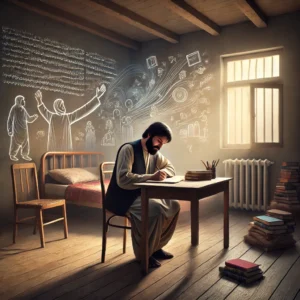by D. Joe Ohlinger | Purdue University Fort Wayne
Planning engaging, relevant, and meaningful discussion, or any lesson for that matter, has been a consistent, often elusive, goal in my two decades as an educator at the elementary, middle school, and now college level. How do you get kids to buy in and care? How can they see their learning as valuable to them right now? My response to this challenge is currently focused on two ideas:
- Revisiting the value of setting purpose by emphasizing self/world connections.
- Reframing critical thinking for students as a means of becoming.
Why choose discussions? Conversation is dynamic, allowing ideas to move from personal lived experience to disciplinary concepts quickly. Cultivating deliberative spaces involves both process and product—students use and benefit from developing critical thinking skills, not just in the service of content goals but in the service of composing a life.
Setting Purpose
Learning must have a worthwhile purpose—and for students that may be as simple as “developing a deeper understanding of self and others” (Levstik & Barton, 2023, p. 15). Children and young adults often ask, ‘Why do we have to learn/do this?’ Our usual response is that it will benefit them in the future, for college or career readiness. Standards and curricula have been determined by adults, and educators face significant content coverage demands. While the topics, facts, and information continuously change during the semester, there is one element that remains constant—the personhood, or subjective self of the student (Palmer, 1998).
Text-to-Self Connections
Cultivating the self of the learner may not be reflected in standards, and while there are many ways to define and operationalize what self may mean, it nonetheless shows up as a major social studies theme: identity.
Students explore through narratives and biographies, the personalities, motivations, belief systems, significance, agency, and life histories of individuals past and present, as well as diverse groups according to demographics, culture, geography, political affiliation, occupation, etc. Students may also encounter the intersectionality of identity by examining culture, language, race, class, biological sex, gender, and lived experience.
Why not invite students more intentionally to consider their identities? Surely, many of them are asking questions as they march through an analysis of people and events in history. Who am I? What are my values, beliefs, interests, dreams, and goals? What are my questions, fears, and insights about life, family, relationships, vocations, the environment, power, and the common good? What does the pursuit of happiness mean? What is my story? Where do I have agency? Making social studies relevant can involve developing students’ capacity to appropriate their education, compose their lives, show up in the world, and engage with life, which is just a broader way of describing civic participation.
The Inevitable Relevance of Critical Thinking
Students use critical thinking skills to analyze the past, often through source work or any time we ask them to make sense of content. It’s worth showing students how these skills apply to understanding themselves. We aren’t learning how to reason just for class—but to become thoughtful, competent, and ethical human beings on this planet.
While critical thinking is a vast and highly valued topic, with many lines of research, I’ve found that the Foundation for Critical Thinking (n.d.) frames reasoning in ways that demonstrate their existential relevance. Drawing from a set of 35 dimensions for critical thought, I use four to establish a main purpose for engaging in discussion. My intention is to help students see and buy into critical thinking as both process and product for their personal growth through deliberation.
Developing One’s Perspective–Creating or Exploring Beliefs, Arguments, or Theories: This dimension highlights the subjective self and suggests that students “know what their perspectives are and can talk insightfully about them … [and] create and explore their own beliefs, their own reasoning, and their own theories.” In addition, this critical thinking skill asks learners to draw upon not just academic prior knowledge, but also their lives. Students “develop their points of view through a critical analysis of their [lived] experience.”
Listening Critically–The Art of Silent Dialogue: This dimension explains that listening is an activity that ultimately benefits oneself. “We must take the words of another and translate them into ideas that make sense to us. We must continually interpret what others say within the confines of our experiences.” We are curriculum for each other. We read text and listen to others because it is edifying as we make sense of who we are.
Questioning Deeply–Raising and Pursuing Root or Significant Questions: In this aspect, critical thinking means exploring human concerns that evoke universal experiences like love, death, truth, beauty, etc. In addition, and “perhaps more important, are basic questionseveryone faces about what people are like, the nature of right and wrong, how we know things, and so on.”
Practicing Socratic Discussion–Clarifying and Questioning Beliefs, Theories, or Perspectives: Here, students begin to learn that deliberation is a skill that involves exploring, testing, and grappling with ideas and issues; it’s not about finding correct answers or certainty:
“When confronted with a new idea, they want to understand it, to relate it to their experience, and to determine its implications, consequences, and value.”
There are myriad Socratic discussion protocols, and for social studies many involve formal debates where students use evidence and reason to make, defend, and deliberate claims. Students often think critical thinking skills are exclusively used in the classroom. The dimensions discussed above structure both the expectations and personal relevance of learning to think through deliberation.
Real-World Events
Paulo Freire (1970) advocated for teaching students to “read the world.” This refers to interrogating how social, political, and economic circumstances shape our identities and lived experiences. Like connections to self, connections to the real world help build existential relevance. Practically anything in social studies can be tied to a current event, issue, problem, or question. Any time we do this, the learning becomes more authentic. James Beane (1993) advocates for a thematic middle school curriculum based on ideas at the intersection of student concerns and social concerns. For example, an excerpt from a table in his book provides three examples of how to connect social studies with topics of personal relevance to young people.
| Understanding Personal Changes | TRANSITIONS | Living in a Changing World |
| Personal Friendships | CARING | Social Welfare |
| Personal Fitness | WELLNESS | Environmental Protection |
In Practice
For one assignment in my secondary methods course, teacher candidates are tasked with designing a discussion. This involves establishing purpose in order to make the lesson existentially relevant. In the sample lesson below, a group of students did this by making connections between understandings (Wiggins & McTighe, 2005) derived from the standard and students’ lives. Below is a succinct rendition of their plan.
Title: Should the government create laws for the common good, even if they limit individual freedom?
Standard: USG.5.5 – Identify when it is constitutional for our government to limit the rights of individuals and explain the reasons why the government would want to do this.
Focus Question: Should the government require vaccines to stop the spread of COVID-19?
Purpose: The purpose of this lesson is to discuss the conflict between protecting individual rights and enacting laws for the betterment of society as a whole. Students will evaluate under what conditions, if any, the government may limit individual freedoms for the common good.
Scenario and Questions:
- You’re 16 years old, and you start hanging out with new friends that you really like. They often wear clothing with racially offensive and aggressive messages on them. One of them gives you a shirt as a gift, and you wear it at home, in front of your parents. They become very upset, demand that you get rid of it immediately, and forbid you to hang out with those friends ever again. Are they overreacting and being unfair? Why or why not?
Here, students grapple with a social, parenting, and relationship dilemma that they very well may have experienced. This has to do with navigating the needs of me vs. others. Students have to think about the moral/ethical dimension. They have to consider the perspectives of parents, perhaps younger siblings, and their own emotions having to abide by a boundary they do not like. An effective discussion, using talk moves, will get many students chiming in. Collectively, the class evaluates the dilemma. All of this is civics in the context of a family dynamic. Deliberation is when we consider the views, needs, wants, and demands of others; consider implications; learn to know when and why something is worth taking a stand on; develop a sense of the common good; see the value of consensus, etc.
- You have three younger siblings, and your parents tell you they that are worried your shirt will be a bad influence on them. Does your answer change? If so, how does it change? Do you understand your parents’ decision better, even if you don’t like it?
The next question problematizes the scenario—and students’ thinking. All of a sudden, consideration for the common good comes into the picture, consensus is on the horizon, and empathy and ethical implications become relevant.
The final four questions move from personal to social concerns.
- Should adults have unlimited freedom of speech and expression? Are there acceptable limits the government puts on individual freedoms?
- Do you think the government should limit the freedoms of people who aren’t vaccinated due to the ongoing pandemic?
- Do you think the government has the right to mandate the vaccine? If so, do you think they should mandate the vaccine?
- Is protecting public health an acceptable reason to limit individual freedom?
When students have had a chance to grapple with the core ideas (Wiggins & McTighe, 2005) and make sense of them in their own lives, they are much more prepared to engage with big themes and questions in the larger world.
References
- Beane, J. (1993). A middle school curriculum: From rhetoric to reality. National Middle School Association.
- The Foundation for Critical Thinking. (n.d.). Strategy list: 35 dimensions of critical thought. Center for Critical Thinking Community Online. http://www.criticalthinking.org/pages/strategy-list-35-dimensions-of-critical-thought/466#s22
- Freire, P. (1970). Pedagogy of the oppressed. Bloomsbury.
- Levstik, L. S., & Barton, K. C. (2023). Doing history: Investigating with children in elementary and middle schools (6th ed.). Routledge.
- Palmer, P. J. (1998). The courage to teach: Exploring the inner landscape of a teacher’s life. Jossey-Bass.
- Wiggins, G., & McTighe, J. (2005). Understanding by design (2nd ed.). Association for Supervision and Curriculum Development.




